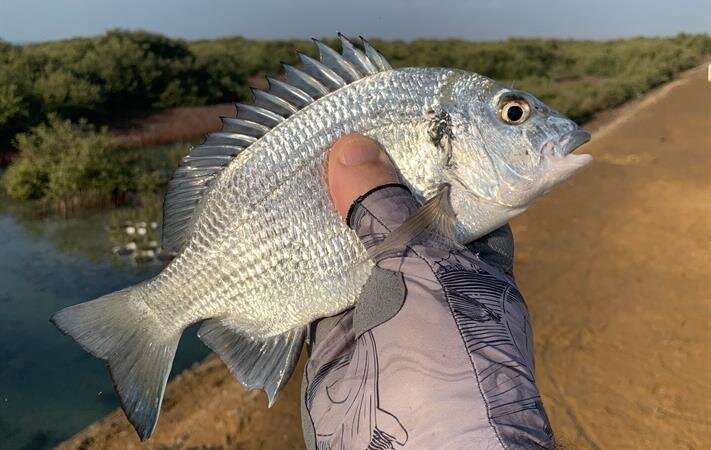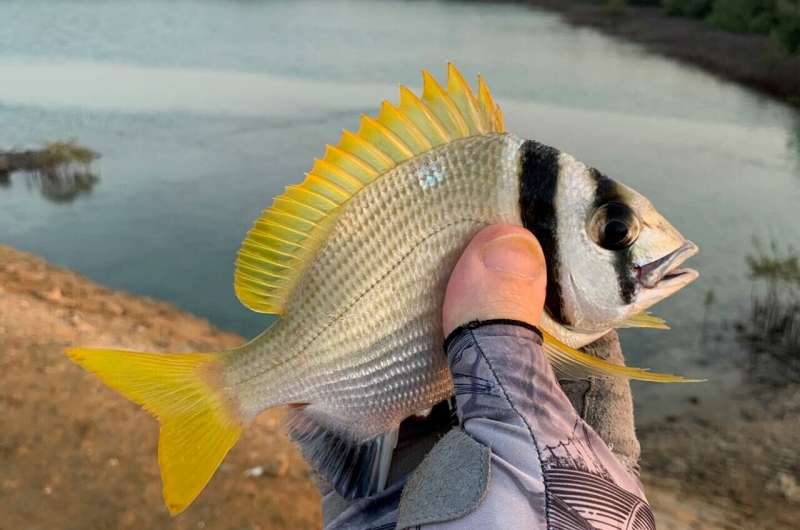Researcher discovers a new species of sea bream (Sparidae) from the Red Sea

Avid fishers from the shoreline at King Abdullah University of Science and Technology (KAUST) near Thuwal, Saudi Arabia know well the three common species of Red Sea sea bream: the goldsilk, or picnic sea bream (Acanthopagrus berda), the double-bar sea bream (Acanthopagrus bifasciatus) and the haffara sea bream (Rhabdosargus haffara). And now they know one more, thanks to KAUST Vice President for Research Dr. Donal Bradley, Distinguished Professor of Materials Physics, and self-described "piscatorial ichthyologist"—a phrase coined by Bradley that refers to one who studies fish by fishing.
"I had been catching both Acanthopagrus species (mostly A. berda) for a while by bait fishing with shrimp and sometimes squid or bread," Bradley said. "I noticed that some of the fish I caught, although superficially similar to A. berda, had some distinctly unique features."
The "new fish" had a more shallowly sloping forehead, a distinct black patch on the rearward edge of the gill cover, a more yellowish pectoral fin, and paler body color. Bradley was not able to find it in any fish-guide books or websites.
In February 2021, Bradley asked marine scientist and Director of the KAUST Red Sea Research Center (RSRC) Dr. Mike Berumen if this could be a new species, providing him with a fin clipping from the "new fish" and, for comparison, a clipping from a standard A. berda caught at the same time.
Berumen's team undertook a genetic analysis, sparking a more detailed study, with results that were sufficiently interesting to prompt an email thread among Berumen's team with the subject line: "I hope the VP hasn't eaten that fish."

Unfortunately, he had. Bradley redoubled his fishing efforts, hoping to catch some specimens of what was now considered a new species.
"Catching more samples proved difficult for a while, prompting my younger daughter to suggest to my wife that I had probably found an unrecognized species and also made it extinct," Bradley said.
Also enlisted in the quest to find the fish was Ph.D. student Collin Williams, the then vice president of the KAUST Fishing Club. Eventually, Bradley caught one, and Williams, with others from RSRC, used a tidal trap on the KAUST North Beach to catch more. A detailed study of these specimens included direct comparison of their physical morphology and genetics with other sea bream from the region (A. berda, A. bifasciatus and R. haffara), Arabian Gulf (A. arabicus, A. sheim, and A. catenula), and with records online.
Finally, the "new fish" was determined to be a distinct species with its closest relative, the Wandering Sea Bream (A. vagus), inhabiting long stretches of the Indian Ocean coast of South Africa and Mozambique.
A recently published paper in the Journal of Fish Biology, Acanthopagrus oconnorae, a new species of seabream (Sparidae) from the Red Sea, details the findings.
"The proposed scientific name for the species, Acanthopagrus oconnorae, honors my mother, Mrs. Winefride Bradley (née O'Connor), on the occasion of her 90th birthday," Bradley said. "The proposed common name, Bev Bradley's Bream, honors my wife. I never imagined I would discover a new species of fish when I decided to take up fishing again at KAUST, after a long period of fishing inaction in the U.K., and I am sure that I have very slim chances of doing so again."
One of the surprises about the discovery, Bradley suggested, is that a relatively large fish (up to ~30 cm in length) had eluded identification until now, despite the earliest studies on sea bream in the region beginning around 250 years ago. Nor had it been reported at local fish markets, suggesting that it is not a staple of commercial fishing. One conjecture from the RSRC team is that this fish favors shallow water in and around mangrove stands, which is not a regular target for fisheries activity or scientific diving.
The other message to take from this discovery, he said, is that there is so much yet to be explored in the Red Sea.
"The ongoing challenge to catch more of the species that live along the shores of the Red Sea and to learn a lot more about these fish and their habitats through piscatorial ichthyology endeavors will definitely keep KAUST anglers busy for many weekends to come," he said.
More information: Lucía Pombo‐Ayora et al, Acanthopagrus oconnorae , a new species of seabream (Sparidae) from the Red Sea, Journal of Fish Biology (2022). DOI: 10.1111/jfb.15147
Journal information: Journal of Fish Biology
















